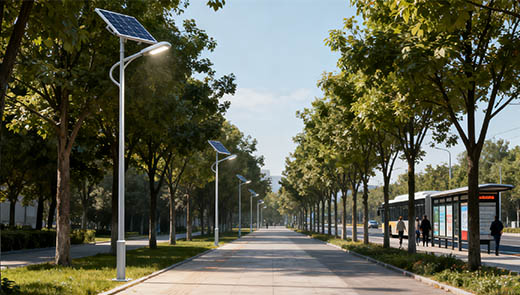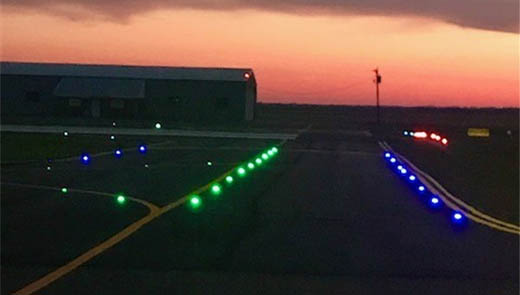How To Choose The Right Installation Height For Solar Street Lights
With the popularity of green energy, solar street lights have become a popular choice for lighting roads and parks due to their energy-saving and environmentally friendly features. However, the choice of installation height is crucial for solar street lights to give the best lighting effect. It not only affects the lighting quality, but also the efficiency of the solar panel and the service life of the street light.
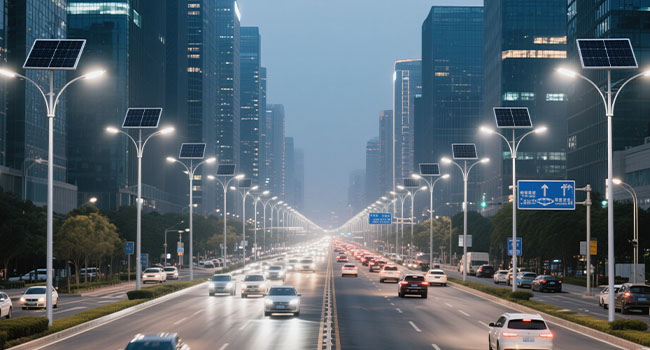
Why Is the Height of Solar Street Lights Important?
Impact on Light Distribution
The installation height of led solar street lights directly determines the coverage and uniformity of light. If the installation height is too low, the light will be concentrated in a small area, resulting in insufficient illumination in the surrounding area; if the installation height is too high, the light will be too scattered, making it difficult to meet the lighting needs. For example, in narrow alleys installed too high street lights, light can not effectively illuminate the ground, pedestrians will still feel dim; and in the wide square installed too low street lights, can only illuminate the local, resulting in lighting blind spots.
Impact on Solar Panel Efficiency
The efficiency of solar panels in receiving sunlight is closely related to the installation height. The length and angle of sunlight received by solar panels vary at different heights. Usually, a higher position reduces shading from surrounding buildings or trees, allowing the solar panel to receive more sunlight, thus improving charging efficiency. However, too high a mounting height may also increase the impact of wind and other factors on the solar panels, so comprehensive consideration is needed.
Impact on Lighting Experience
A suitable mounting height can bring a comfortable lighting experience. For pedestrians, street lights at the right height can provide soft, even light and avoid blinding glare; for drivers, a reasonable lighting height can ensure that the road is clearly visible and reduce traffic accidents caused by lighting problems. On the contrary, street lights of inappropriate height can produce glare or dead spots, interfering with the visual experience.
Factors That Affect the Installation Height of Solar Street Lights
Lighting Coverage and Brightness Requirements
Different places have different lighting coverage and brightness requirements, which determines the installation height of Solar Street Lights:
|
Location Type |
Recommended Installation Height |
Lighting Characteristics |
Function |
|
Main Roads and Highways |
10 - 12 meters |
Wide and even coverage |
Reduces shadows, enhances road safety |
|
Small Roads and Parking Lots |
6 - 8 meters |
Focused illumination |
Improves visibility in the area |
|
Residential Areas and Gardens |
3 - 4 meters |
Cozy and localized lighting |
Avoids over-lighting, creates a comfortable ambiance |
Main roads and highways have high traffic volume, high speed, and a wide range of vehicles and pedestrians, so they need a wider and more uniform illumination range. 10 - 12 m installation height can make the light effectively cover the entire road surface, reduce the shadow area, so that drivers can clearly observe the road conditions, traffic signs and obstacles in advance, so as to react in time and reduce the probability of traffic accidents.
Small roads and parking lots usually have relatively limited space, vehicle and pedestrian activities are more concentrated, more need to focus on lighting to improve the local brightness. 6 - 8 m installation height can focus the light on a specific area, such as parking spaces in parking lots, the road surface of small roads, convenient for vehicles and pedestrians to walk, but also to avoid the waste of light.
Homes and gardens are private spaces for people's daily life and leisure, focusing on creating a warm, comfortable and quiet atmosphere, without the need for overly strong lighting. 3 - 4 meters of lower installation height can not only meet the basic lighting needs of residents walking along the path at night, entering and exiting their homes, but also will not affect the residents' rest and quality of life due to overly bright light, soft light can also add a sense of warmth.
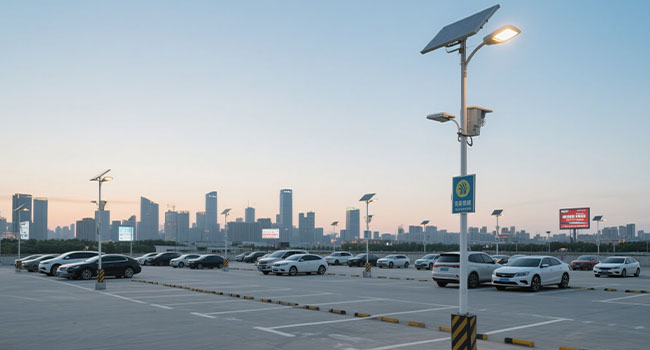
Type of Light and Beam Angle
Type of Light and Beam Angle is also an important basis for choosing the installation height.
Wide Beam Angle Luminaires: These luminaires are suitable for installation at a height of 10 - 12 meters. Because of its ability to evenly distribute light over a wide area, the high installation position allows it to take full advantage of the large area coverage without loss of light intensity, suitable for plazas, large parking lots and other areas.
Narrow Beam Angle Luminaires: Narrow beam angle luminaires are more suitable for lower installation heights of 6 - 8 meters. Installed in a lower position, it can focus light on a specific area to meet the concentrated lighting needs of alleys, courtyards and other small areas.
Weather and Environmental Conditions
In areas with strong winds and frequent rainstorms, such as coastal areas frequently hit by typhoons and windy areas in high mountains, the wind is more destructive to street lights. Higher street light poles are subjected to greater wind pressure under strong winds and are prone to swaying or even collapse. Therefore, not only need to choose a higher strength, more stable pole, such as the use of thickened steel, special reinforced structure of the pole, but also need to appropriately reduce the height of the installation, in order to enhance the wind resistance of street lights. For example, in a city on the southeast coast of China, a number of high-pole street lights collapsed due to typhoons in the past, and then the installation height of the street lights was reduced from 10 meters to 8 meters, and the structure of the lamp poles was strengthened, which effectively reduced the damage rate in the subsequent typhoons.
Areas with high light intensity, such as the Tibetan Plateau and Northwest China, have long sunshine hours and strong solar radiation. In these places, the installation height can be appropriately increased so that the solar panels can obtain more sufficient sunlight to enhance the power generation efficiency. Because the higher position can reduce the surrounding terrain, buildings, etc. on the sun's shade, so that the solar panels receive sunlight for a longer period of time, the angle is more optimal. In areas with short light hours and weak intensity, such as some high latitude areas or mountainous areas with perennial fog, it is necessary to consider lowering the installation height to reduce the shading of solar panels by neighboring objects and to improve the charging efficiency of solar panels as much as possible.
In snowy areas, snow covering the solar panels in winter will seriously affect their power generation efficiency and even lead to failure of charging. A higher mounting height can utilize gravity and wind to make the snow slide off more easily, avoiding snow from piling up on the surface of the solar panels for a long time. At the same time, higher poles also make it easier for staff to use specialized equipment to clean up the snow and ensure that the solar panels work properly.
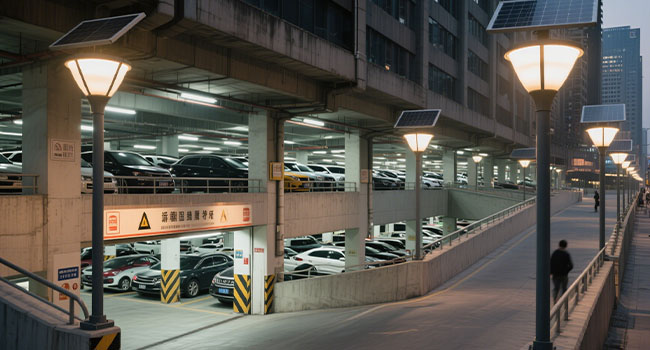
Aesthetic and Safety Considerations
Solar led street lights not only assume the function of lighting, but also part of the environmental landscape. From the aesthetic point of view, the installation height should be coordinated with the surrounding landscape. In the historical and cultural neighborhoods, often choose 3 - 4 meters of low street lights, with antique modeling, and ancient buildings, stone road style echo; and modern commercial streets with 8 - 10 meters of high-pole street lights, combined with LED light bands and other elements, to show the sense of urban science and technology.
Safety is also critical. Street lights installed too low, easy to be cut by vehicles or pedestrians unintentionally collision, especially in traffic and crowded areas, there is a risk of damage and safety hazards. On the contrary, the installation of too high will cause light pollution, affecting the residents to rest, and high-altitude maintenance of professional equipment, cost and risk of double rise. When choosing the height, it is necessary to take into account the aesthetics, safety and lighting function, to achieve a balance between the three.
How to Install Solar Street Lights at the Right Height
Choose the Right Pole Height
From the point of view of the lighting needs of the place, the city's main roads need to ensure a long distance, large area of continuous lighting, light pole height is usually set at 8-12 meters to ensure that the light can cover the two-way lanes and sidewalks; the internal roads and walking paths in the community on the brightness of the requirements of the lower for the purpose of creating a comfortable atmosphere of lighting, the height of light poles can be controlled in the 3-5 m. The light pole height can be set at 8-12 meters to ensure that the light can cover the two-way lanes and sidewalks. Different types of lights and lanterns on the lighting range and light projection angle of the impact should not be ignored, the traditional high-pressure sodium lamp luminous angle is larger, can be used with higher poles; and LED street lights concentrated light is strong, the height of the pole can be appropriately reduced.
Environmental conditions are equally critical, in coastal typhoon prone areas, light poles need to have a higher level of wind resistance, in addition to increasing the height, but also through the thickening of the tube wall, reinforcing the base to ensure stability; snowy areas should consider the snow on the pressure of the light poles, choose the right height at the same time, optimize the structural design of the light poles, to avoid the center of gravity due to the snow caused by the shift. In addition, the pole must have sufficient strength and stability, the material should be able to withstand the weight of the street lights, solar panels, and at the same time through scientific calculations and mechanical testing to ensure that the extreme weather conditions are still solid and reliable.
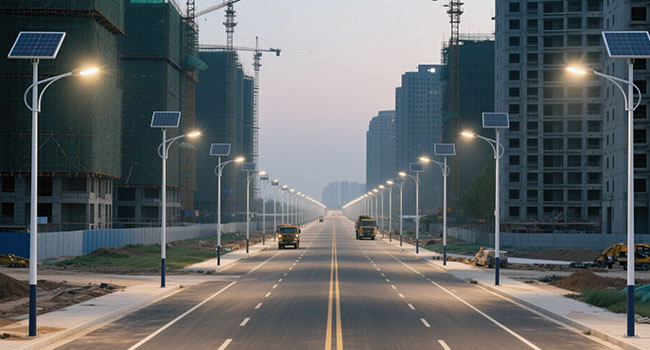
Place the Light at an Optimal Angle
Reasonable adjustment of the angle of the lamp is the key to realize efficient lighting. In road lighting scenarios, according to the width of the road and the direction of vehicular traffic, the angle of the lights should be precisely adjusted to project light evenly onto the road surface, reduce visual fatigue brought about by alternating light and darkness, and improve driving safety. For example, for a two-way four-lane road, the angle of the lights can be set to tilt downward by 15-20 degrees to ensure that the light can effectively cover the entire road surface. For courtyard lighting, according to different functional areas to adjust the angle of the lights, in the leisure area, the angle of the lights down to 30-45 degrees, can focus the light to illuminate the seats, coffee tables and other areas, to create a warm and comfortable atmosphere. Through this angle adjustment, not only can meet the lighting needs of different places, but also can effectively reduce the light scattering to the sky or irrelevant areas, reduce light pollution and improve energy efficiency.
Ensure Proper Solar Panel Exposure
The installation angle and position of solar panels determine their power generation efficiency. In the northern hemisphere, solar panels are usually installed facing south, while in the southern hemisphere, they are installed facing north to maximize sunlight reception. At the same time, the tilt angle of the solar panel should be adjusted according to the local latitude and seasonal changes. Generally speaking, when the tilt angle is equal to the local latitude, the solar panel's average power generation efficiency will be higher in a year.
When installing, it is necessary to conduct a detailed survey of the surrounding environment, avoiding the installation of street lights in trees, buildings and other places that may produce shadows. If it is not possible to avoid shading, it is necessary to accurately calculate the shadow coverage time and select the location and angle for installation where the shadow impact is minimized. In addition, regular cleaning and maintenance of solar panels is required to remove dust, bird droppings, snow and other stains on the surface to ensure its surface cleanliness in order to maintain high photoelectric conversion efficiency.
Choosing the right solar street light installation height is a balancing art of function, efficiency and sustainability. By taking into account lighting needs, fixture type, environmental challenges, and the harmony of aesthetics and safety, both the quality of illumination and the efficiency of the solar panels' power generation can be maximized. Whether illuminating a busy highway or punctuating a quiet garden path, the core goal remains the same: to create light-filled, energy-efficient spaces that enhance safety, reduce carbon footprints, and stand the test of time. With careful planning and attention to detail, solar street lights can transform any environment into a brighter, greener, more sustainable place.


